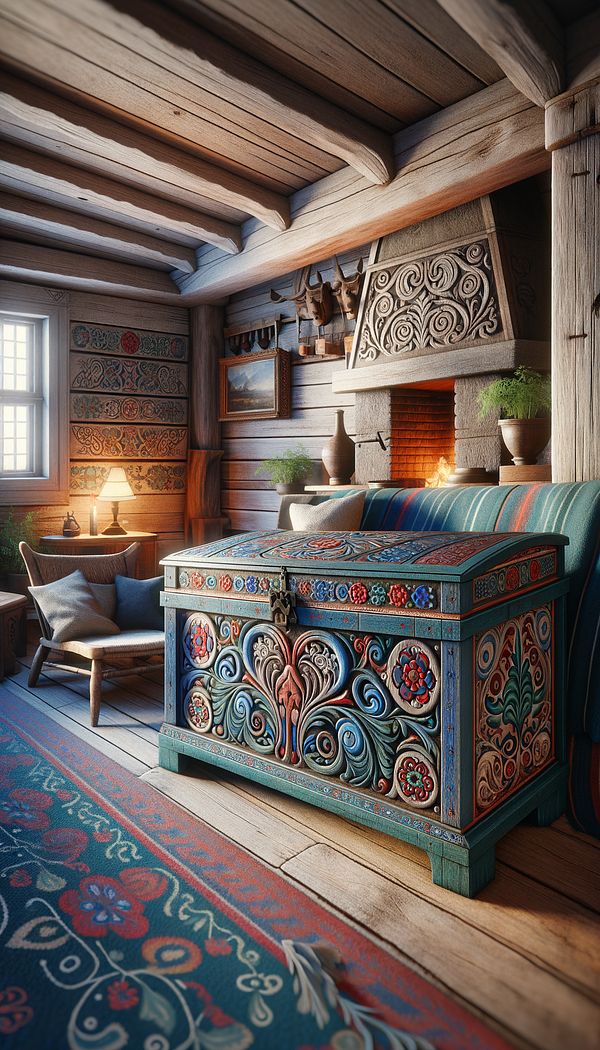What is Rosemaling?
Rosemaling is a traditional Norwegian decorative painting technique.
Description
Rosemaling, or 'rose painting' as it translates from Norwegian, is an exquisite form of decorative folk art that emerged in Norway around the 18th century. It is characterized by its fluid, swirling patterns and detailed designs that often incorporate flowers, scrollwork, and sometimes scenes from nature or mythology. Originally, this art form was applied to wooden objects and furniture as a means of beautification and to express individual artistic flair in rural communities.
Over time, Rosemaling has evolved and adapted, incorporating influences from various European art trends of the 17th and 18th centuries, notably the Baroque, Regency, and Rococo styles. The practice has varied significantly across different regions of Norway, each developing its own distinctive style. The most notable styles include Telemark and Hallingdal, characterized by their dynamic compositions and vivid color schemes.
Today, Rosemaling is cherished both as a historical craft and a living art form, practiced by artists around the world. It adds a distinct, personalized touch to interiors, often used on furniture, wall treatments and finishes, and decorative objects. This technique not only enhances the aesthetic appeal of an interior space but also pays homage to a rich cultural heritage.
Usage
Rosemaling can be featured in contemporary and traditional homes alike. It might adorn the surfaces of furniture pieces such as chests, cabinets, and chairs, or grace the walls as part of a stunning mural or decorative panel. Besides its historical use on wooden items, modern applications have expanded to include textiles, ceramics, and even metalwork, showcasing this versatile art's ability to complement various interior design aesthetics, from rustic to eclectic.
FAQs
-
Is Rosemaling appropriate for modern interior designs?
Yes, Rosemaling can be beautifully integrated into modern interior designs. Its intricate patterns and vibrant colors can add a unique touch of artistry and personalization to more contemporary spaces, serving as a focal point or a unifying theme within a room.
-
How is Rosemaling applied in interior design?
In interior design, Rosemaling is applied through hand-painted decorations on walls, furniture, and decorative items. It can also be incorporated into fabric designs or replicated in wallpaper patterns, offering a versatile way to introduce this traditional art form into various spaces.
-
Can Rosemaling be customized?
Absolutely. One of the beauties of Rosemaling is its adaptability. Artists can customize patterns, color schemes, and motifs to fit the specific design goals of a space, making each application of Rosemaling as unique as its creator's vision.
Practical Application
When incorporating Rosemaling into interior spaces, it is important to consider the overall theme and color scheme of the room to ensure that the patterns and colors harmonize with the existing design. It can serve as a standalone feature or be part of a larger decorative techniques|decorative theme, depending on the desired impact. For those interested in integrating Rosemaling into their space, commissioning a skilled artisan or becoming familiar with the style through research and practice is advised to achieve authentic results.
-
Furniture Types599 articles
-
Decorative Techniques322 articles
-
Color & Patterns154 articles
-
Textiles & Upholstery252 articles
-
Wall Treatments & Finishes157 articles
-
Cast Iron FurnitureCast iron furniture refers to items of furniture made primarily from cast iron, a type of iron that has been melted, poured into molds, and allowed to solidify.
-
BailBail refers to a type of handle or pull on drawers, cabinets, or furniture.
-
MohairMohair is a luxurious, durable fabric made from the hair of the Angora goat.
-
Beveled EdgeA beveled edge refers to an edge of a structure that is not perpendicular to the faces of the piece.
-
CanterburyA Canterbury is a type of portable, open-topped furniture designed to hold sheet music or books.
